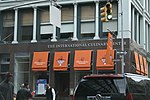The Canal Street station is a New York City Subway station complex. It is located in the Manhattan neighborhoods of Chinatown and SoHo, and is shared by the BMT Broadway Line, the IRT Lexington Avenue Line, and the BMT Nassau Street Line. It is served by the 6, J, N, and Q trains at all times; the R train at all times except late nights; the W train during weekdays; the <6> train during weekdays in the peak direction; the Z train during rush hours in the peak direction; and the 4 train during late nights.
The complex comprises four stations, all named Canal Street; the Broadway Line's local and express tracks stop at separate sets of platforms. The Lexington Avenue Line platforms were built for the Interborough Rapid Transit Company (IRT), and was a local station on the city's first subway line. The station opened on October 27, 1904, as one of the original 28 stations of the New York City Subway. The other three stations were built for the Brooklyn Rapid Transit Company (later the Brooklyn–Manhattan Transit Corporation, or BRT) as part of the Dual Contracts. The Nassau Street Line station opened on August 4, 1913; the Broadway Line express station opened on September 4, 1917; and the Broadway Line local station opened on January 5, 1918. The IRT station was connected to the BMT stations in 1978. Several modifications have been made over the years, including a full renovation between 1999 and 2004.
The Lexington Avenue Line station, under Lafayette Street, has two side platforms and four tracks; express trains use the inner two tracks to bypass the station. The Nassau Street Line station, under Centre Street, has two island platforms and three tracks, but only one platform and two tracks are in use. The Broadway local station, under Broadway, has two side platforms and four tracks, the inner two of which are not in use. The Broadway express station, under Canal Street, has two side platforms and two tracks, running at a lower level than the other three sets of platforms. The Lexington Avenue Line platforms contain elevators from the street, which make it compliant with the Americans with Disabilities Act of 1990, but the other platforms do not have elevator access.








